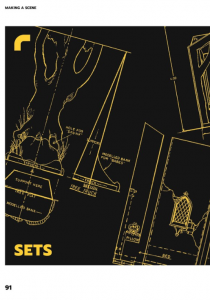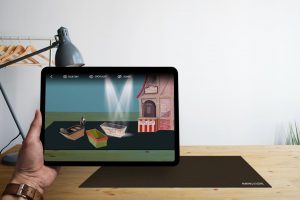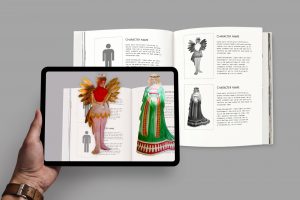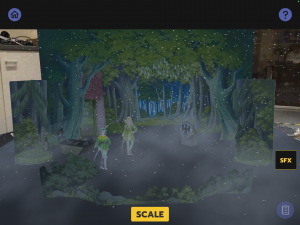Theatre is a collaborative art form. It takes a whole team of people to take a play from page to stage. All too often though, we only pay attention to the people performing onstage. Those who work backstage go unseen by the audience, and it is difficult to know just what they do, and what career opportunities exist.
Using Bristol Old Vic’s archives held at the University of Bristol Theatre Collection, Making A Scene (funded by the Museums Association Digital Innovation and Engagement fund) aims to fill this knowledge gap by giving young people across Bristol the chance to peek behind the curtain….
These blogs, written by staff involved in the project from the University of Bristol Theatre Collection, Bristol Old Vic and Zubr, a Bristol based Augmented Reality and Virtual Reality studio, are a behind the scenes look at the process of creating this behind the scenes resource.
‘Making a Scene’ is my ideal project. It draws together the three stages of my own career (if you’ll pardon the pun): theatre, collections and digital interpretation. It’s also been a wonderful opportunity to collaborate again with the Theatre Collection, Bristol Old Vic and Zubr. We first worked together on the Window to the Past app and since then I’ve left Bristol Old Vic’s engagement team to work for Zubr, so this project has been something of a reunion despite a few role changes!
With an established partnership from the get-go, developing the ‘Making a Scene’ app has been a real opportunity to flex our creative muscles and design a playful and hands-on AR experience. We knew we wanted to make an app which retained and celebrated the physicality of collections despite being delivered through AR technology, and after two years of isolated, online learning due to the COVID-19 pandemic it was also important to us to create an experience that encouraged teamwork and discussion.
In September 2021 we hosted a concept meeting for the project team at Zubr’s Studio to test some of Zubr’s past projects and discuss our initial ideas for the app. We wanted it to be fun but age-appropriate. Aimed at 16-25 year olds interested in offstage careers, the content couldn’t be too gamified or simplistic. With this in mind, we agreed to design an AR ‘pop-up book’ that users could scan with an iPad to cause 3D models of objects from the Theatre Collection to appear above the page. Users could then select different models and combine them to create sets for selected scenes from our chosen production: Babes in the Wood, 2000.
Following the concept meeting, our Graphic Designer Miriam used recent lighting plans and CAD drawings supplied by Bristol Old Vic to inform the branding and set the stage for the app. The lilac, blue, yellow and black colour palette references backstage elements like gaffa tape, the glow of a sound desk, and the soft velvet of blackout cloths, whilst the app logo is a modern take on the classic theatre mask motif.

After confirming the branding, Miriam created mock ups for the experience which showed Theatre Collection and Bristol Old Vic staff what we were aiming to achieve. Next she designed the user interface for the app, working with our developers to ensure users could intuitively navigate the app. Miriam then used photoshop to cut out over 80 digitised 2D designs from the Bristol Old Vic archive at the Theatre Collection so they could be included as chooseable assets in the app.


Our Creative Director Chris advised Theatre Collection Photography and Digitisation Officer Sarah on how best to capture the model box pieces, exploring photogrammetry techniques and suggesting different settings and post-production software. Sarah then sent us the 3D models she captured, and our 3D modeller Joe prepared them for inclusion in the app. This involved reducing polycounts, removing green screen tinges, fixing holes, smoothing and scaling, adding lost details back in, making texture adjustments, and general clean up.
Whilst we waited for the 3D models, our developer Jake began building the app interface and screens based on the mock ups and UI designs Miriam had made. He incorporated text and instructions I’d written to inform users about the experience, and built different functions including a spotlight effect which highlights the asset users have selected; a budget tracker so users can see what each asset would cost and how much they’ve spent; different special effects; a carousel that shows different backdrops; and put all 2D assets onto vertical planes so they could be positioned in 3D space. Once the 3D models were ready, Jake added them into the app and began testing. Here’s a film of the app in its early stages, shot in the office carpark!
The app lets you choose characters, backdrops, set pieces, and props, see them in miniature, then scale them up to lifesize so you can walk around inside and among them. We then added special effects and lighting to really bring the AR content to life, and give you a taste of being a theatre technician.

Meanwhile Miriam was designing the layout for the book which contained further digitised archival material, instructions, and the tracking images which allow the app to interact with the book. She designed the tracking images in the same style as the app branding, transforming relevant designs and plans into colourful, high contrast images that an iPad camera could pick up.
As a project manager, my role has involved content decisions about the app structure and features, maintaining momentum on the project, informing Theatre Collection and Bristol Old Vic staff on progress, and lots of testing!
‘Making a Scene’ has been a true team effort and we’re really pleased with how the project has been developing. The app is being tested in demo workshops and being able to support the Theatre Collection and Bristol Old Vic staff at these and see people using the app is proving a very rewarding, and an effective way of working out what still needs tweaking.
The final result will be a playful experience rooted in real-life decision making and delivered through genuine archival material realised in AR. It’s a very unique use of augmented reality, but we’ve already had several commercial companies interested in something similar for exhibition, TV/film sets or festival builds. Despite (or perhaps because of?) its panto-theme, ‘Making a Scene’ is on its way to becoming an ideal tool for those wanting to dip a toe into the world of backstage theatre careers.
